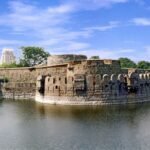The history Palace in “Padmanabhapuram Palace is the oldest, largest, and well preserved surviving example of traditional wooden architecture in India”.
Padmanabhapuram Palace
The Padmanabhapuram Palace, an architectural masterpiece located in the town of Padmanabhapuram, in the Kanyakumari District of Tamil Nadu, India, stands as a testament to the rich cultural and historical legacy of the region. It served as the residence of the rulers of the erstwhile Kingdom of Travancore from the 16th century until the mid-19th century, before the capital was moved to Thiruvananthapuram (formerly Trivandrum). Today, the palace is a popular tourist attraction and an important cultural landmark, offering insights into the grandeur and opulence of royal life in South India. This article delves into the history of Padmanabhapuram Palace, its architectural marvels, and the significance it holds in the history of Kerala and the Travancore Kingdom.
Early History and the Establishment of the Kingdom of Travancore
The history of Padmanabhapuram Palace is intrinsically linked to the rise of the Travancore Kingdom, which was established in the 18th century. However, the origins of the palace date back earlier, to the 16th century. The area around Padmanabhapuram, once known as “Anizham,” was under the control of the local rulers, known as the Venad kings. Venad was a Tamil kingdom that later became a part of the Travancore region after the consolidation of power in the 18th century.
In 1601, the Venad Kingdom was ruled by King Marthanda Varma, whose reign significantly altered the political landscape of the region. The Travancore Kingdom formally emerged as an independent state under the leadership of King Marthanda Varma’s descendants.
The location of the Padmanabhapuram Palace was strategically chosen for its proximity to the region’s water resources, which provided both natural beauty and security. The palace was situated within the royal capital of the Kingdom of Travancore, a center of political and cultural life.
The Construction of Padmanabhapuram Palace
The construction of Padmanabhapuram Palace was begun in the 16th century under the reign of King Iravi Varma, the ruler of the Venad dynasty. The palace, originally a modest structure, was later expanded and embellished by successive rulers, particularly by Marthanda Varma in the 18th century. The palace is named after the Hindu god Vishnu, whose idol is housed in the Padmanabhaswamy Temple located nearby in Thiruvananthapuram.
Marthanda Varma, who ascended the throne of Travancore in the early 18th century, is credited with transforming the palace into a grand architectural structure. His reign marked the consolidation of the Travancore state and the beginning of its rise as a powerful kingdom in southern India. During his rule, the palace underwent significant additions, making it a symbol of the kingdom’s wealth and power. The intricate wooden carvings, the elegant Kerala-style architecture, and the lavish interiors reflect Marthanda Varma’s vision for the royal residence.
The Architecture of Padmanabhapuram Palace
The architectural style of Padmanabhapuram Palace is a unique blend of traditional Kerala style and influences from European colonial designs. This fusion of styles is particularly evident in the use of wooden beams, red-tiled roofs, and intricately carved pillars, alongside European elements such as high-ceilinged rooms and large windows, which were incorporated during the 17th and 18th centuries.
One of the key features of the palace is the extensive use of wood, especially teak, in its construction. The palace complex consists of multiple sections, including the King’s quarters, audience halls, and ceremonial rooms. The wooden ceilings, walls, and floors are adorned with intricate carvings depicting mythological stories, scenes of royal life, and images of gods and goddesses from Hindu mythology.
Among the most notable architectural features is the use of wooden columns and beams, which are beautifully carved with geometric patterns and motifs. The use of wood for construction was chosen not only for its aesthetic appeal but also for its durability in the humid climate of Kerala. The craftsmanship and attention to detail reflect the skilled artisans who worked on the palace over the centuries.
The palace complex is also known for its open courtyards and sprawling gardens, which provide a serene and peaceful atmosphere. The central courtyard of the palace is a place where ceremonial functions, royal meetings, and other important events were held. The palace was designed to facilitate both private and public functions, with different sections of the complex serving different purposes. The presence of large open spaces within the palace reflects the traditional design of Kerala houses, which often emphasize natural ventilation and the harmonious integration of indoor and outdoor spaces.
The Interior and Key Sections of the Palace
The interiors of Padmanabhapuram Palace are equally spectacular, with opulent furnishings and decor that reflect the grandeur of the Travancore Kingdom. Some of the most remarkable features of the palace include the following:
- The King’s Quarters: The private chambers of the king, where he lived and held his personal meetings, are located in the eastern wing of the palace. The rooms are elegantly designed with carved wooden furniture and beautifully painted ceilings. The bed in the King’s Quarters is said to be the same one used by King Marthanda Varma.
- The Council Chamber: This room was used by the king and his ministers for important administrative meetings and decisions. The chamber is decorated with a series of portraits of the Travancore rulers, including that of Marthanda Varma himself.
- The Valiya Sala (Main Hall): The Valiya Sala is the largest hall in the palace and was used for holding grand ceremonies, celebrations, and meetings with foreign dignitaries. It is characterized by its massive wooden beams, tall windows, and the strikingly beautiful ceiling, which features intricate artwork and carvings.
- The Drawing Room: The Drawing Room of the palace is known for its opulent decoration, including large mirrors, chandeliers, and delicate carvings on the walls. It was here that the royal family received important visitors.
- The Armoury: The palace also houses an impressive collection of arms and armaments, including swords, shields, and firearms, many of which were used by the rulers of Travancore in battles during the 18th and 19th centuries.
- The Manthrasala: The Manthrasala is the ceremonial room where royal decrees were issued and where official matters were discussed. This room is adorned with beautiful paintings and carvings that depict scenes from Indian mythology.
- The Courtyard and Gardens: The palace grounds include well-maintained gardens with manicured lawns, potted plants, and trees, adding to the beauty and tranquility of the space. The palace is built around several open courtyards, providing an airy and spacious atmosphere.
The Decline of the Padmanabhapuram Palace
Despite its grandeur, the importance of Padmanabhapuram Palace began to wane in the mid-19th century when the capital of the Travancore Kingdom was shifted to Thiruvananthapuram (formerly Trivandrum) in 1795. Thiruvananthapuram was more strategically located, being closer to the coast and offering better access to trade routes, which were increasingly important for the kingdom’s economic prosperity.
Following the move of the capital, Padmanabhapuram Palace ceased to be the main seat of government and royal residence. However, it continued to be used for ceremonial and cultural purposes. Over time, the palace began to show signs of deterioration, as it was no longer maintained with the same care as it had been during the royal reign.
During the 20th century, the palace fell into disuse, and many of its treasures were scattered or lost. However, in the latter part of the century, efforts were made by the Government of Kerala to restore the palace to its former glory. The palace was declared a protected monument and was renovated with the help of experts in historical conservation and architecture.
The Restoration and Present Day
The restoration of Padmanabhapuram Palace began in earnest in the 1990s. The Kerala State Government took steps to preserve the structure, and the Palace was declared a protected monument under the Archaeological Survey of India (ASI). The restoration project included the repair of the wooden panels, reinstallation of artwork, and conservation of historical artifacts.
Today, Padmanabhapuram Palace stands as one of the finest examples of traditional Kerala architecture, and it continues to attract visitors from around the world. The palace complex has been preserved not only as a tourist attraction but also as a site of historical and cultural importance. Many of the royal artifacts, paintings, and antiques housed within the palace have been restored and are on display, providing a glimpse into the opulent lifestyle of the Travancore kings.
The palace remains a symbol of the Travancore royal family’s cultural and architectural legacy, and it is an important part of the region’s history. It offers visitors an opportunity to explore the grandeur of a bygone era and to appreciate the architectural and artistic achievements of Kerala’s royal dynasty.
Conclusion
Padmanabhapuram Palace is not just an architectural marvel; it is a living testament to the rich history of the Travancore Kingdom and the cultural heritage of Kerala. From its humble beginnings as a royal residence to its status today as a preserved historical monument, the palace has played a central role in the life of the region for centuries. Its unique architectural features, lavish interiors, and historical significance make it a must-visit destination for anyone interested in the history, art, and culture of South India.
As efforts to restore and preserve the palace continue, Padmanabhapuram Palace will undoubtedly remain an important part of Kerala’s heritage for generations to come. Through its blend of tradition, history, and artistic excellence, it continues
The History of Padmanabhapuram Palace
The Padmanabhapuram Palace, an architectural masterpiece located in the town of Padmanabhapuram, in the Kanyakumari District of Tamil Nadu, India, stands as a testament to the rich cultural and historical legacy of the region. It served as the residence of the rulers of the erstwhile Kingdom of Travancore from the 16th century until the mid-19th century, before the capital was moved to Thiruvananthapuram (formerly Trivandrum). Today, the palace is a popular tourist attraction and an important cultural landmark, offering insights into the grandeur and opulence of royal life in South India. This article delves into the history of Padmanabhapuram Palace, its architectural marvels, and the significance it holds in the history of Kerala and the Travancore Kingdom.
Early History and the Establishment of the Kingdom of Travancore
The history of Padmanabhapuram Palace is intrinsically linked to the rise of the Travancore Kingdom, which was established in the 18th century. However, the origins of the palace date back earlier, to the 16th century. The area around Padmanabhapuram, once known as “Anizham,” was under the control of the local rulers, known as the Venad kings. Venad was a Tamil kingdom that later became a part of the Travancore region after the consolidation of power in the 18th century.
In 1601, the Venad Kingdom was ruled by King Marthanda Varma, whose reign significantly altered the political landscape of the region. The Travancore Kingdom formally emerged as an independent state under the leadership of King Marthanda Varma’s descendants.
The location of the Padmanabhapuram Palace was strategically chosen for its proximity to the region’s water resources, which provided both natural beauty and security. The palace was situated within the royal capital of the Kingdom of Travancore, a center of political and cultural life.
The Construction of Padmanabhapuram Palace
The construction of Padmanabhapuram Palace was begun in the 16th century under the reign of King Iravi Varma, the ruler of the Venad dynasty. The palace, originally a modest structure, was later expanded and embellished by successive rulers, particularly by Marthanda Varma in the 18th century. The palace is named after the Hindu god Vishnu, whose idol is housed in the Padmanabhaswamy Temple located nearby in Thiruvananthapuram.
Marthanda Varma, who ascended the throne of Travancore in the early 18th century, is credited with transforming the palace into a grand architectural structure. His reign marked the consolidation of the Travancore state and the beginning of its rise as a powerful kingdom in southern India. During his rule, the palace underwent significant additions, making it a symbol of the kingdom’s wealth and power. The intricate wooden carvings, the elegant Kerala-style architecture, and the lavish interiors reflect Marthanda Varma’s vision for the royal residence.
The Architecture of Padmanabhapuram Palace
The architectural style of Padmanabhapuram Palace is a unique blend of traditional Kerala style and influences from European colonial designs. This fusion of styles is particularly evident in the use of wooden beams, red-tiled roofs, and intricately carved pillars, alongside European elements such as high-ceilinged rooms and large windows, which were incorporated during the 17th and 18th centuries.
One of the key features of the palace is the extensive use of wood, especially teak, in its construction. The palace complex consists of multiple sections, including the King’s quarters, audience halls, and ceremonial rooms. The wooden ceilings, walls, and floors are adorned with intricate carvings depicting mythological stories, scenes of royal life, and images of gods and goddesses from Hindu mythology.
Among the most notable architectural features is the use of wooden columns and beams, which are beautifully carved with geometric patterns and motifs. The use of wood for construction was chosen not only for its aesthetic appeal but also for its durability in the humid climate of Kerala. The craftsmanship and attention to detail reflect the skilled artisans who worked on the palace over the centuries.
The palace complex is also known for its open courtyards and sprawling gardens, which provide a serene and peaceful atmosphere. The central courtyard of the palace is a place where ceremonial functions, royal meetings, and other important events were held. The palace was designed to facilitate both private and public functions, with different sections of the complex serving different purposes. The presence of large open spaces within the palace reflects the traditional design of Kerala houses, which often emphasize natural ventilation and the harmonious integration of indoor and outdoor spaces.
The Interior and Key Sections of the Palace
The interiors of Padmanabhapuram Palace are equally spectacular, with opulent furnishings and decor that reflect the grandeur of the Travancore Kingdom. Some of the most remarkable features of the palace include the following:
- The King’s Quarters: The private chambers of the king, where he lived and held his personal meetings, are located in the eastern wing of the palace. The rooms are elegantly designed with carved wooden furniture and beautifully painted ceilings. The bed in the King’s Quarters is said to be the same one used by King Marthanda Varma.
- The Council Chamber: This room was used by the king and his ministers for important administrative meetings and decisions. The chamber is decorated with a series of portraits of the Travancore rulers, including that of Marthanda Varma himself.
- The Valiya Sala (Main Hall): The Valiya Sala is the largest hall in the palace and was used for holding grand ceremonies, celebrations, and meetings with foreign dignitaries. It is characterized by its massive wooden beams, tall windows, and the strikingly beautiful ceiling, which features intricate artwork and carvings.
- The Drawing Room: The Drawing Room of the palace is known for its opulent decoration, including large mirrors, chandeliers, and delicate carvings on the walls. It was here that the royal family received important visitors.
- The Armoury: The palace also houses an impressive collection of arms and armaments, including swords, shields, and firearms, many of which were used by the rulers of Travancore in battles during the 18th and 19th centuries.
- The Manthrasala: The Manthrasala is the ceremonial room where royal decrees were issued and where official matters were discussed. This room is adorned with beautiful paintings and carvings that depict scenes from Indian mythology.
- The Courtyard and Gardens: The palace grounds include well-maintained gardens with manicured lawns, potted plants, and trees, adding to the beauty and tranquility of the space. The palace is built around several open courtyards, providing an airy and spacious atmosphere.
The Decline of the Padmanabhapuram Palace
Despite its grandeur, the importance of Padmanabhapuram Palace began to wane in the mid-19th century when the capital of the Travancore Kingdom was shifted to Thiruvananthapuram (formerly Trivandrum) in 1795. Thiruvananthapuram was more strategically located, being closer to the coast and offering better access to trade routes, which were increasingly important for the kingdom’s economic prosperity.
Following the move of the capital, Padmanabhapuram Palace ceased to be the main seat of government and royal residence. However, it continued to be used for ceremonial and cultural purposes. Over time, the palace began to show signs of deterioration, as it was no longer maintained with the same care as it had been during the royal reign.
During the 20th century, the palace fell into disuse, and many of its treasures were scattered or lost. However, in the latter part of the century, efforts were made by the Government of Kerala to restore the palace to its former glory. The palace was declared a protected monument and was renovated with the help of experts in historical conservation and architecture.
The Restoration and Present Day
The restoration of Padmanabhapuram Palace began in earnest in the 1990s. The Kerala State Government took steps to preserve the structure, and the Palace was declared a protected monument under the Archaeological Survey of India (ASI). The restoration project included the repair of the wooden panels, reinstallation of artwork, and conservation of historical artifacts.
Today, Padmanabhapuram Palace stands as one of the finest examples of traditional Kerala architecture, and it continues to attract visitors from around the world. The palace complex has been preserved not only as a tourist attraction but also as a site of historical and cultural importance. Many of the royal artifacts, paintings, and antiques housed within the palace have been restored and are on display, providing a glimpse into the opulent lifestyle of the Travancore kings.
The palace remains a symbol of the Travancore royal family’s cultural and architectural legacy, and it is an important part of the region’s history. It offers visitors an opportunity to explore the grandeur of a bygone era and to appreciate the architectural and artistic achievements of Kerala’s royal dynasty.
Padmanabhapuram Palace is not just an architectural marvel; it is a living testament to the rich history of the Travancore Kingdom and the cultural heritage of Kerala. From its humble beginnings as a royal residence to its status today as a preserved historical monument, the palace has played a central role in the life of the region for centuries. Its unique architectural features, lavish interiors, and historical significance make it a must-visit destination for anyone interested in the history, art, and culture of South India.
As efforts to restore and preserve the palace continue, Padmanabhapuram Palace will undoubtedly remain an important part of Kerala’s heritage for generations to come. Through its blend of tradition, history, and artistic excellence, it continues









